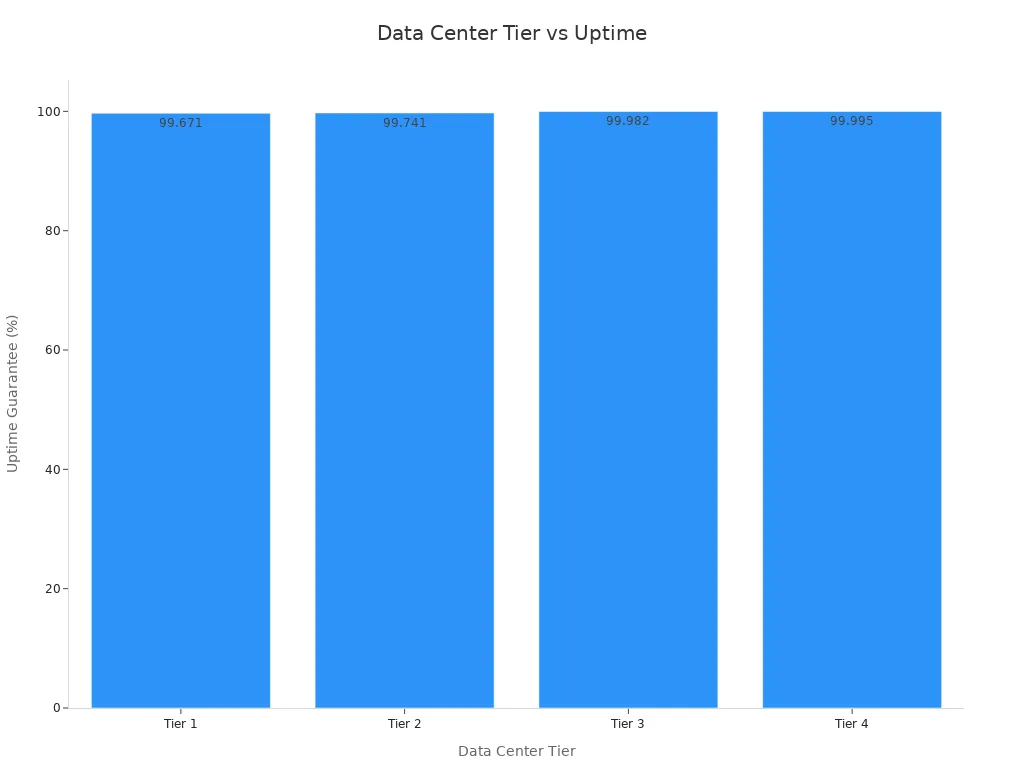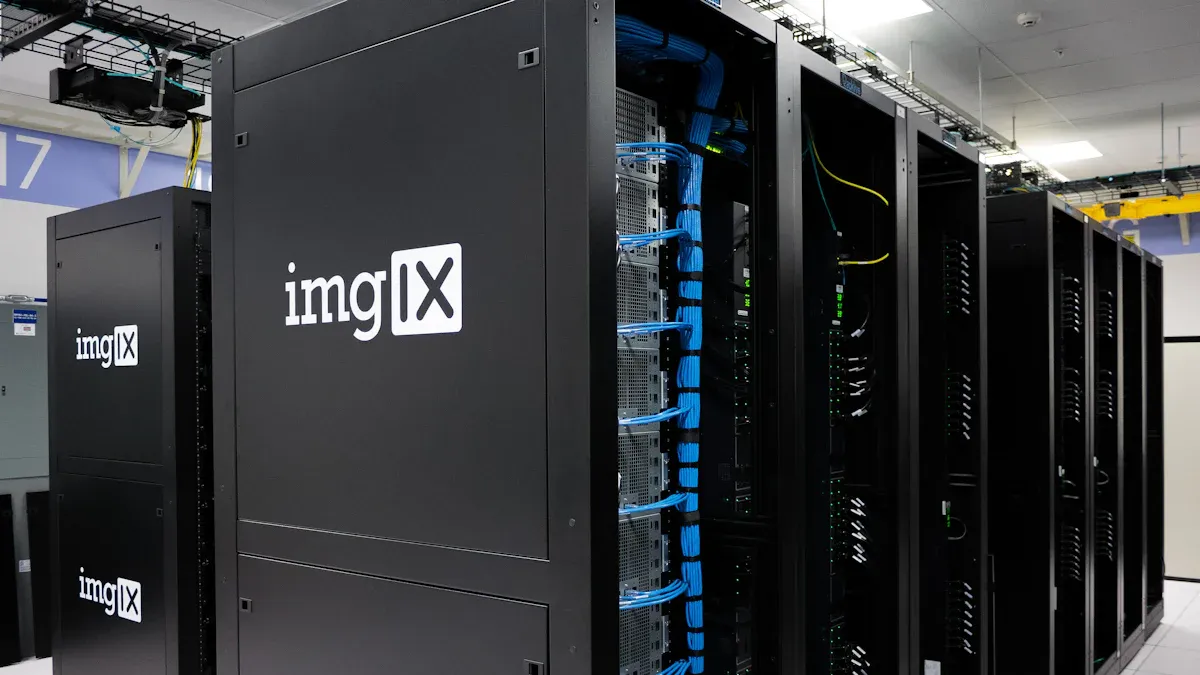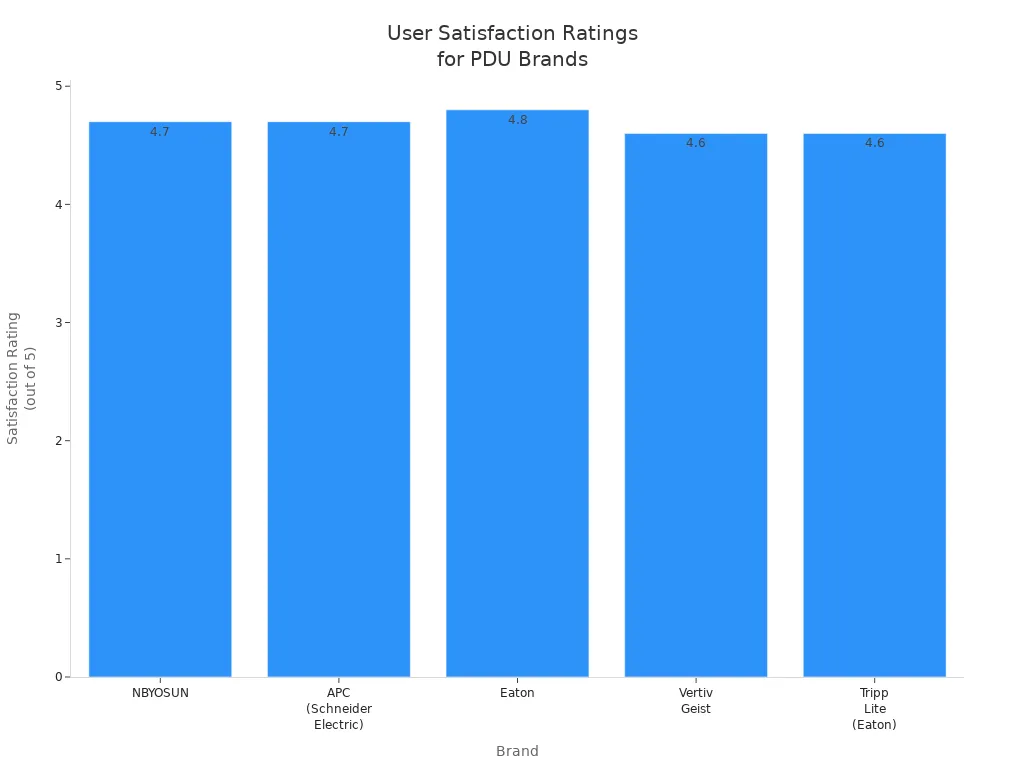© Copyright – 2010-2023 : All Rights Reserved. Sitemap
Power Distribution Unit PDU, rack mount PDU, PDU data center, Smart PDu, intelligent PDU
Power Distribution Unit PDU, rack mount PDU, PDU data center, Smart PDu, intelligent PDU
DTI-CX 2025 Digital Transformation Indonesia Conference, DATE:6-7 AUG.2025, Booth No.: C21

When you choose a network pdu, you focus on stats that shape how your network grows and performs. Smart pdu stats like power capacity, outlet type, and monitoring features let you plan power needs and prevent overloads. You gain real-time data for efficient troubleshooting and maintenance.

You need to consider power capacity first when selecting a network pdu. Power capacity defines how much electrical load your pdu can handle. High-density network equipment, such as servers and switches, demands robust power support. PDUs with higher ratings, sometimes reaching up to 55kW or more, provide enough headroom for these power-hungry devices. Three-phase PDUs deliver higher voltages at lower currents, which helps you distribute power efficiently and use smaller cables.
Circuit breakers or fuses limit the maximum current each pdu circuit can carry. For safety, you should load circuits to only 80% of their maximum capacity. This practice prevents tripping and keeps your network running smoothly. For example, a 20A circuit should not exceed 16A in actual use. You calculate apparent power (VA) using the derated current and voltage, which helps you plan your network pdu deployment.
Tip: Choose a pdu with enough power capacity to support future growth. This approach ensures you avoid overloads and maintain reliable operation as your network expands.
Lower power capacity PDUs work well for small data centers or office setups. They offer simple installation and lower costs. Larger data centers need PDUs with higher power ratings to support more equipment and provide better scalability.
Outlet count and type play a key role in pdu compatibility. The number of outlets determines how many devices you can connect directly. The type of outlet affects which devices you can plug in without adapters. Common outlet types include C13, C19, and NEMA plugs. C13 outlets fit smaller IT equipment, while C19 outlets support high-power devices like servers. NEMA plugs work for general IT gear.
PDUs with mixed outlet types give you flexibility. You can connect different devices seamlessly, reducing the need for adapters. Matching the outlet type and capacity to your devices’ voltage and amperage needs prevents overloads and ensures stable operation.
| Outlet Type | Typical Use | Power Rating |
|---|---|---|
| C13 | Small IT equipment | Up to 10A |
| C19 | Servers, storage | Up to 16A |
| NEMA | General IT devices | Varies by model |
You should always check the outlet configuration before purchasing a network pdu. This step helps you avoid compatibility issues and supports safe, reliable power distribution.
Monitoring capabilities set smart pdu products apart from basic models. You gain real-time visibility into power consumption, load balancing, and environmental conditions. Modern PDUs track current, voltage, temperature, and humidity. These features help you spot inefficiencies and prevent overheating.
Intelligent pdu monitoring sends instant alerts when it detects anomalies. You receive notifications by email or SMS, allowing you to respond quickly and avoid downtime. Remote management lets you control individual outlets and perform reboots without visiting the site. This feature saves time and reduces maintenance costs.
Note: Environmental sensors in smart pdu units monitor temperature and humidity. They help you maintain optimal conditions and prevent hardware failures.
Integration with management systems and APIs enables automation and predictive maintenance. You can schedule firmware updates and device replacements before problems occur. Load balancing features distribute power evenly, preventing overloads and extending equipment lifespan.
PDUs with advanced monitoring capabilities support proactive maintenance. You optimize power distribution, reduce operational costs, and lower the risk of unplanned outages. These features make smart pdu solutions essential for modern network environments.
Remote management features transform how you control and monitor your network pdu. You gain the ability to manage power from anywhere, which saves time and reduces the need for on-site visits. Modern pdu models offer a range of remote management tools that help you respond quickly to incidents and keep your network running smoothly.
Key remote management features include:
These features help you optimize energy use, reduce downtime, and improve operational efficiency. You can also scale your pdu deployment as your network grows, thanks to modular and expansion port options.
Remote management capabilities have a direct impact on response time during network incidents. The table below shows how these features improve your ability to handle problems quickly and maintain network reliability:
| Feature | Impact on Response Time and Incident Handling |
|---|---|
| Real-time alerting | Enables immediate detection of issues, allowing faster response |
| Auto ticketing and alarms | Automates incident reporting, reducing manual delays |
| Remote management | Provides reliable visibility and control from any location, eliminating on-site delays |
| Embedded analytics | Supports proactive maintenance through pattern and anomaly detection |
| Remote power cycling | Allows targeted rebooting of devices remotely, minimizing downtime |
You can see a 40% improvement in maintenance response times when you use remote monitoring. Automated incident categorization and AI-driven anomaly detection further speed up your response, helping you keep your network stable and efficient.
Tip: Choose a pdu with advanced remote management features to reduce downtime and improve your network’s resilience.
Environmental sensors in your pdu play a critical role in protecting your equipment. These sensors monitor conditions like temperature, humidity, airflow, smoke, flooding, and even vibrations. By tracking these factors, you can detect problems early and prevent equipment failure.
PDUs with integrated environmental sensors send real-time alerts if they detect overheating, excessive moisture, or abnormal vibrations. You receive notifications by email, SMS, or SNMP traps, allowing you to act before issues escalate. This proactive approach reduces downtime and extends the life of your hardware.
You often find these sensors placed near server racks, under raised floors, and close to HVAC systems. They monitor the environment where it matters most. When you connect your pdu to a DCIM system, you centralize monitoring and make preventive maintenance easier.
When you select a pdu, consider the type and placement of environmental sensors. Look for options that match your infrastructure and provide accurate, reliable data. This investment helps you maintain optimal conditions and avoid costly outages.
Redundancy and failover features in a pdu ensure your network stays online, even if something goes wrong. High-availability pdus use several strategies to eliminate single points of failure and provide continuous power.
Common redundancy and failover features include:
The chart below shows uptime guarantees across different data center tiers, highlighting the importance of redundancy and failover in maintaining high availability:

When you choose a pdu with these features, you minimize downtime and protect your critical systems. Automatic failover mechanisms switch to backup power within milliseconds, so your equipment keeps running without interruption. Regular testing and proactive maintenance ensure your redundancy systems work when you need them most.
Note: Selecting a pdu with ATS and dual power inlets is essential for environments where uptime is critical. These features provide effective failover and redundancy, keeping your network safe and operational.
When you select a pdu for your network, form factor and mounting options play a crucial role in how well your equipment fits and functions within the rack. The right choice helps you maximize space, improve airflow, and simplify cable management. You often see two main types of form factors: vertical (0U or Zero U) and horizontal (1U or 2U). Each offers unique advantages for rack mounted power distribution.
Here is a comparison to help you understand the differences:
| Aspect | Vertical PDUs (0U or Zero U) | Horizontal PDUs (1U or 2U) |
|---|---|---|
| Space Utilization | Mount on rack side rails, saving rack space and allowing more outlets | Occupy 1U or 2U rack space within the rack, fewer outlets |
| Cable Management | Shorter cable runs, reduced tangling, improved airflow | Structured cable layout, reduces cable clutter |
| Installation | Tool-less mounting, easier installation and maintenance | Requires rack space and cooling considerations |
| Power Capacity | Higher outlet count, suitable for high power demands | Fewer outlets, suitable for moderate power needs |
| Airflow & Cooling | Better airflow due to side mounting and less cable clutter | Improved airflow by reducing cable clutter |
You can see that vertical PDUs mount along the side rails of your rack. This design saves valuable rack space for servers and switches. You gain more outlets and higher power capacity, which is ideal for dense data center environments. Horizontal PDUs fit into the rack like other equipment, occupying 1U or 2U of space. These work well for smaller setups or when you need a structured cable layout.
Mounting options for your pdu also affect airflow and cable management. Consider these points when planning your installation:
You should always match the form factor and mounting style of your pdu to your network’s needs. Vertical mounting works best when you want to maximize rack space and outlet count. Horizontal mounting provides a familiar layout and fits well in smaller racks. Proper planning ensures efficient rack mounted power distribution, keeps cables organized, and maintains optimal airflow for cooling.
Tip: Choose a pdu with tool-less mounting options for faster installation and easier maintenance. This feature saves time and reduces the risk of errors during setup.
A well-chosen form factor and mounting method help you achieve a clean, organized, and efficient network rack. You protect your equipment, simplify maintenance, and support future growth.
You depend on your network to stay online at all times. Reliable PDUs help you achieve this goal by offering features like overload protection, surge suppression, and real-time monitoring. When you use PDUs with advanced monitoring, you receive instant alerts about abnormal conditions. This allows you to act quickly and prevent downtime. Dual input designs and automatic transfer switches provide backup power paths, so your equipment keeps running even if one source fails. You can trust these features to protect your servers and switches from unexpected power issues.
Tip: Choose PDUs with built-in safety features and remote monitoring to increase your network’s uptime and reduce the risk of outages.
Efficient power use lowers your operational costs and supports your sustainability goals. Power Usage Effectiveness (PUE) is a key metric you can track with modern PDUs. A lower PUE means your data center uses less energy for overhead, such as cooling and lighting. Smart PDUs let you monitor voltage, current, and power factor at the outlet level. This helps you spot inefficiencies and balance loads across your equipment.
You can use these insights to identify underutilized servers and consolidate workloads. This approach reduces your energy bills and supports long-term sustainability.
As your network grows, you need PDUs that can adapt. Modular designs let you expand capacity by adding new modules instead of replacing entire units. Plug-and-play features allow you to upgrade quickly without major disruptions. Hot-swappable parts keep your network running during upgrades, so you avoid downtime.
| Feature | Benefit |
|---|---|
| Modular architecture | Add capacity without replacing the whole unit |
| Plug-and-play | Upgrade fast with minimal disruption |
| Hot-swappable parts | Maintain operation during upgrades |
| Intelligent PDUs | Adjust power remotely as your needs change |
| Multi-voltage support | Stay flexible as your network requirements evolve |
You benefit from these features by reducing future hardware replacements and ensuring your power distribution keeps pace with your network’s demands. This flexibility makes it easier to plan for growth and manage your infrastructure efficiently.
When you evaluate network PDUs, you need to look beyond the initial price tag. The total cost of ownership (TCO) includes not only what you pay upfront but also what you spend on energy, maintenance, downtime, and eventual replacement. Choosing the right PDU can save you money over the long run, even if it costs more at first.
Smart investment in advanced PDUs often leads to lower costs over time, thanks to features that help you manage power more efficiently and reduce downtime.
Here’s a comparison of cost factors over a five-year period:
| Cost Factor | Basic PDUs | Metered/Monitored PDUs | Switched PDUs |
|---|---|---|---|
| Upfront Acquisition | Lower initial cost | Higher due to monitoring | Highest for advanced control |
| Operational Costs | Higher (less efficient) | Reduced by remote management | Lowest with energy optimization |
| Downtime Costs | Higher (manual fixes) | Lower with early alerts | Lowest with remote troubleshooting |
| End-of-Life Costs | Higher (shorter lifespan) | Lower (better management) | Lowest (extended equipment life) |
Although basic PDUs seem budget-friendly at first, you may face higher expenses over five years. These costs come from more frequent replacements, higher energy use, and longer downtimes. Advanced PDUs, such as metered, monitored, or switched models, require a bigger upfront investment but help you save by enabling energy optimization, remote management, and early fault detection. This approach extends the lifespan of your equipment and reduces the risk of costly outages.
Premium PDUs also offer real-time monitoring and environmental sensors. These features can cut energy waste by up to 20% and lower maintenance costs by 15–25%. You respond to issues up to 40% faster, which means less downtime and fewer emergency repairs. Over time, these savings add up, making advanced PDUs a smart choice for your network’s bottom line.

When you compare NBYOSUN with other leading brands, you notice clear differences in features and performance. NBYOSUN PDUs stand out with advanced real-time monitoring and remote management. These smart pdu units help you cut energy use by up to 18%, which leads to real savings each year. You also benefit from proactive alerts that prevent downtime and circuit overloads, making your network more reliable.
Other brands like Eaton focus on fast transfer times and pure sine wave output, which support critical operations. MTA Italy offers compact, modular designs with advanced thermal management. Tripp Lite and Vertiv provide strong build quality and flexible mounting options. Schneider Electric delivers advanced monitoring and space-saving designs.
Here is a comparison table to help you see the differences:
| Brand | Build Quality & Materials | Key Features & Functionalities | Safety & Certifications | Unique Selling Points & Monitoring Capabilities |
|---|---|---|---|---|
| NBYOSUN | Robust aluminum alloy housing | Anti-surge protection, customizable options, switchless design | UL, CE, ISO9001 | Tailored solutions, overload protection, long cable customization |
| Tripp Lite | Rugged all-metal case | Automatic transfer switching, remote monitoring, LCD screen | N/A | Advanced remote management, versatile mounting |
| Eaton | Lightweight aluminum chassis | Integrated outlet grips, remote monitoring, daisy-chaining | N/A | Real-time power data, easy installation |
| Vertiv | Durable build, secure outlets | Dual voltage support, locking outlets | N/A | Voltage flexibility, vibration resistance |
| Schneider Electric | Compact, robust construction | Advanced monitoring, safety features, multiple C13 outlets | N/A | Space optimization, energy tracking |
User satisfaction ratings show that NBYOSUN matches or exceeds top competitors. You get real-time monitoring, remote outlet-level control, and strong reliability. NBYOSUN’s rugged housing and wide outlet spacing add to its durability. The brand’s certifications and focus on customization make it a trusted choice for many large clients.

You can use a checklist to make sure you select the right smart pdu for your needs. This approach helps you avoid common mistakes and ensures your network pdu supports your goals.
Tip: Always add a 20–30% buffer to your power calculations. This step prepares your infrastructure for future growth and unexpected surges.
A structured checklist based on these points helps you avoid undersized units, compatibility issues, and installation problems. You gain confidence that your smart pdu choice will deliver reliable, efficient, and scalable power distribution.
Choosing the right network PDU starts with understanding key stats like power capacity, outlet type, monitoring, and redundancy. These features help you build a network that stays reliable, efficient, and ready for growth. Three-phase PDUs work best for high-demand environments because they balance loads and save energy. To make a smart choice, follow these steps:
Smart planning and the right stats help you protect your network and control costs as your needs grow.
A basic PDU distributes power without monitoring or control features. A smart PDU provides real-time monitoring, remote management, and environmental sensors.
Smart PDUs help you optimize energy use and improve network reliability.
You should match the outlet type to your equipment’s plug.
| Outlet Type | Common Use |
|---|---|
| C13 | Small IT devices |
| C19 | Servers |
| NEMA | General equipment |
Remote management lets you monitor and control power from anywhere. You can reboot devices, receive alerts, and troubleshoot issues quickly.
You should check for certifications like UL, CE, ISO9001, and RoHS.
These certifications ensure safety, reliability, and compliance with international standards.
Key Advantages Of Auto Transfer Switch PDUs Revealed
Why Auto Transfer Switch PDUs Are Absolutely Necessary
A Professional And Leading Manufacturer
For OEM
& ODM Power Distribution Unit (PDU)
You Can Trust
CONTACT
Ningbo YOSUN Electric Technology Co., LTD
Leading Professional Manufacturer in PDU Power Solutions
Contact Info.